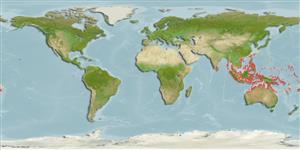Teleostei (teleosts) >
Tetraodontiformes (Puffers and filefishes) >
Tetraodontidae (Puffers) > Canthigasterinae
Etymology: Canthigaster: Greek, kanthos = the outer or inner corner of the eye, where the lids meet, 1646 + Greek, gaster = stomach (Ref. 45335).
Environment: milieu / climate zone / depth range / distribution range
Ecology
Marine; brackish; reef-associated; non-migratory; depth range 2 - 25 m (Ref. 90102). Tropical; 30°N - 21°S
Western Pacific: Philippines to the Solomon Islands, north to Ryukyu Islands and southern Marianas, south to Vanuatu.
Size / Weight / Age
Maturity: Lm ? range ? - ? cm
Max length : 12.0 cm SL male/unsexed; (Ref. 48637)
Inhabits sandy areas of shallow lagoons and channels (Ref. 9710, 48637). Also found in silty bays or harbors around wharf pilings. Adults usually in pairs (Ref. 48637).
Life cycle and mating behavior
Maturities | Reproduction | Spawnings | Egg(s) | Fecundities | Larvae
Allen, G.R. and R. Swainston, 1992. Reef fishes of New Guinea: a field guide for divers, anglers and naturalists. Publication No. 8. Christensen Research Institute, Madang, Papua New Guinea. 132 p. (Ref. 6023)
IUCN Red List Status (Ref. 130435)
Threat to humans
Harmless
Human uses
Fisheries: of no interest
Tools
Special reports
Download XML
Internet sources
Estimates based on models
Preferred temperature (Ref.
123201): 26.6 - 29.3, mean 28.6 °C (based on 1773 cells).
Phylogenetic diversity index (Ref.
82804): PD
50 = 0.5000 [Uniqueness, from 0.5 = low to 2.0 = high].
Bayesian length-weight: a=0.04365 (0.02363 - 0.08064), b=2.91 (2.75 - 3.07), in cm total length, based on LWR estimates for this species & Genus-body shape (Ref.
93245).
Trophic level (Ref.
69278): 3.5 ±0.37 se; based on food items.
Resilience (Ref.
120179): High, minimum population doubling time less than 15 months (Preliminary K or Fecundity.).
Fishing Vulnerability (Ref.
59153): Low vulnerability (10 of 100).
Nutrients (Ref.
124155): Calcium = 91.4 [39.0, 252.0] mg/100g; Iron = 0.863 [0.423, 1.968] mg/100g; Protein = 18.5 [16.3, 20.7] %; Omega3 = 0.14 [0.07, 0.27] g/100g; Selenium = 27.3 [12.4, 60.2] μg/100g; VitaminA = 63.3 [17.6, 246.9] μg/100g; Zinc = 1.77 [1.12, 2.68] mg/100g (wet weight);
